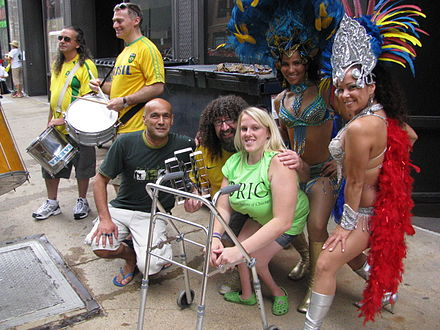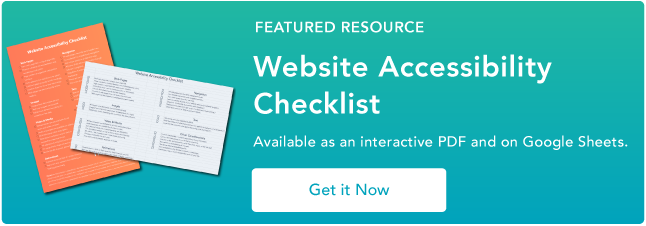A Brief History of Disability Pride [+Why Businesses Should Embrace It]
As a legally blind woman, it took me years to disclose the full extent of my disability to employers. When I did, I downplayed my blindness as "just a bit of nearsightedness," or I had to give a disclaimer of, "It's never held me back and I have references to prove it."
And, if I had to go back in time, I'd do the same thing.
Why? Even if I had a great manager, I couldn't deny the stats that were engrained in my mind. Although one in five U.S. adults has a disability, more than one-third of corporate employees report negative bias or discrimination at work.
If that stat seems tough to swallow, imagine reading it as a young professional with a disability.
Because of hard data, combined with the fact that I knew no one like me in my field, I was terrified to mention my disability.
Now, at HubSpot, I've safely opened up about my blindness. Through doing so, I've met others with disabilities. I've even helped other colleagues to form HubSpot's first Disability Alliance group, which provides education, virtual meetups, and resources to our allies and others in the disabled community.
One thing I've discovered is that disability impacts almost all of us, regardless of race, gender, or geographic region. If you don't have a visible or unseen disability right now, you might learn how to navigate one as you age. If not, you might have a friend or family member that navigates a disability every day.
Unfortunately, there are still employers that will ignore someone's achievements due to physical or mental disabilities. Sadly, because disabled people might be limited by location or financial restraints, they might still have to endure judgment in the workplace to earn a living wage.
Luckily, in 2021, we can and should work towards changing this. And, there's no better time to start than in July (a.k.a. Disability Pride Month).
These endeavors encourage those with disabilities to show pride in what makes them unique while encouraging allies to promote the visibility and representation of those in this group.
Disability Pride Month is also an important time to look back and reflect on all the great strides that the disabled community has made in the past. When we look back on positive historical outcomes, it can motivate us to act for a change and a better future for those with disabilities.
Why Marketers and Businesses Should Embrace Disability Pride
Although Disability Pride Month is only observed in July and primarily within the United States, Disability Pride can be celebrated every day by marketers, managers, and companies around the globe.
While marketers can take time to brainstorm new ways to make their campaigns, offerings, and content more inclusive and accessible, managers and employers can consider how they can help all employees receive the accommodations and support they need to succeed.
To inspire future action and change, here's a brief history of how disability rights have changed and improved around the world -- leading up to Disability Pride Month, declared in 2015. This is not an exhaustive list of wins for the disabled community, but it highlights a few people, landmark court cases, and international events that spread disability awareness or encouraged disability equality.
A Timeline of Disability Pride
Disability in the Late 1800s and Early 1900s
1880-1986: The Era of Helen Keller
Helen Keller, a deaf and blind woman who was nearly institutionalized for her impairments as a child, proved many skeptics wrong when receiving degrees from Radcliffe College, within Harvard University; Cambridge School in Weston; and Wright-Humason School of the Deaf.
Keller went on to work in public service and wrote a number of best-selling books.
Keller's early life and work with teacher Anne Sullivan were chronicled in a groundbreaking book titled "The Miracle Worker."
1930: The Mental Treatment Act 1930
This was an Act of the Parliament of the United Kingdom that permitted voluntary admission to, and outpatient treatment within, psychiatric hospitals. At this point, "asylums" transitioned to "mental hospitals."
1946: Psychiatric Hospital Employees Tried for Murder
German courts tried members of the Hadamar Psychiatric Hospital staff for the murders of nearly 15,000 citizens at the facility. Adolf Wahlmann and Irmgard Huber, the chief physician, and the head nurse, were convicted. This trial was a landmark case that put the livelihood importance on those with mental illnesses as those without them.
1947: Japan Enacts Accessibility Laws
During this year, Japan enacted three laws including
- The School Education Law: Provided education for disabled children such as general classes, special classes, non-residential classes, special schools, and itinerant teaching.
- The Workmen's Accident Compensation Insurance Law: Provided disability pension and disability lump-sum payments, as well as welfare services such as special allowance, medical services, health care, or supply of prosthetic appliances.
- 1947: The Mail Law: Made postage for Braille paper and recorded mail for visually impaired persons are free of charge, and parcels for disabled people can be mailed at half the cost. The postage for periodicals published by disabled person groups can be mailed at a small charge.
1973: Rehabilitation Act. Section 504 is Passed by US Congress
The passage of section 504 of the 1973 Rehabilitation Act guaranteed that people could not be denied services or federal funding on just the basis of disability. It also recognized those with disabilities as a minority for the first time. This law was also incredibly historic because it labeled the exclusion or segregation of children or adults with disabilities as illegal discrimination. Because of this, disabled people were now able to be educated or work in similar roles as those without disabilities.
The landmark law passage was highly publicized and led to more conversations about disability rights and equality in the U.S. Ultimately, it was seen as the foundation for the Americans with Disabilities Act.
Disability Pride Celebrations Begin with the ADA
1988-1990: The Americans With Disabilities Act is Proposed and Passed
The ADA was drafted in 1988, brought through Congress within the next two years, and was ultimately passed and celebrated by President George H.W. Bush in 1990.
In its earliest form, the act aimed to protect those with disabilities from discrimination both in and out of the workplace. A few of the act's major regulations include:
- State and local governments must give people with disabilities an equal opportunity to benefit from all of their programs, services, and activities (e.g. public education, employment, transportation, recreation, health care, social services, courts, voting, and town meetings).
- Employers with 15 or more employees must provide qualified individuals with disabilities an equal opportunity to benefit from the full range of employment-related opportunities available to others.
- The act prohibits discrimination in recruitment, hiring, promotions, training, pay, social activities, and other privileges of employment and restricts questions that can be asked about an applicant's disability before a job offer is made.
- All employers must make reasonable accommodation to the known physical or mental limitations of otherwise qualified individuals with disabilities unless it results in an undue hardship.
- Public transportation authorities can't discriminate against people with disabilities in the provision of their services.
- Public transit must also comply with requirements for accessibility in newly purchased vehicles, make good faith efforts to purchase or lease accessible used buses, remanufacture buses in an accessible manner.
- Paratransit must also be provided on fixed-route bus or rail systems.
- Businesses must comply with basic nondiscrimination requirements that prohibit exclusion, segregation, and unequal treatment. They also must comply with specific architectural standards for new and altered buildings, such as reasonable modifications to policies, practices, and procedures. Additionally, public businesses must remove physical disability barriers in buildings.
Disability Pride Celebrations Begin
The first Disability Pride Day was held in Boston in 1990 to coincide with the passing of the ADA. Later, in 2004, the first Disability Pride Parade in the U.S. was held in Chicago, which made the celebration an annual tradition in the city after the first drew thousands of people into the city.

Disability Pride did not become a full month until 2015 -- when Mayor Bill De Blasio designated July as Disability Pride Month in New York state to celebrate ADA's 25th anniversary. Aside from 2020, when public gatherings were canceled, NYC's Disability Pride Month Parade has become a major annual celebration that pulls in people from all around the world.
Disability Pride Today
In the past decade, we've seen more representation of disabled people in the media and workplaces than ever before. While there are still a number of changes we're fighting for, equality rights have come a long way. Here are a few great examples of where we're seeing groundbreaking disability pride:
Books
One area where disability stories have particularly been embraced is in the world of literature. Even in the 1900s, we had groundbreaking books like, "The Miracle Worker" which followed the early life of Helen Keller (noted above). Today, there are thousands of great works written by disabled figures, their advocates, or their followers. Here's just one long list to start with.
Television
Here are two awesome examples of current or upcoming shows that feature disabled actors playing a character with a disability:
Crip Camp: A Disability Revolution (Netflix, YouTube)
This Netflix documentary follows a groundbreaking Woodstock-era summer camp that inspired a group of teens with disabilities to build a movement and forge a new path toward equality and independence.
Ramy (Hulu)
A few members of HubSpot's Disability Alliance have recommended Ramy, a Hulu dramedy that follows a first-generation American Muslim, played by comedian Ramy Youssef, on a "spiritual journey in his politically divided New Jersey neighborhood."
While the show's been buzzed about for its plotline, it's also made news because Youssef cast his best friend, a standup comedian with muscular dystrophy named Steve Way, to play his onscreen pal.
Here's an interview Way gave about the show and how the casting was a groundbreaking move in streaming content:
This Is Us (NBC, Peacock, Hulu)
The most recent seasons of This Is Us have partially followed the parents of a blind character named Jack. As Jack grows up, he gains independence, struggles as a musician, and eventually becomes a famous singer and parent. Not only is the story hopeful, but the character is incredibly realistic because he's actually played by a blind man.
Here's an interview with Blake Stadnik, who plays Jack, talking about his experience on This Is Us:
Social Media
Social media has become a major platform for those with disabilities, and their allies, to tell their stories. Below is a list of just a few great accounts to follow, courtesy of HubSpot's Disability Alliance:
- Diversability: Instagram, Website
- Tiffany Yu (Founder of Diversability)
- Sinéad Burke: Website, Twitter, Podcast
- Tess Daly: Instagram
- Jillian Mercado: Instagram
- Tae McKenzie: Instagram, Website
- Madeline Stuart: Instagram, Website
- Haben Girma: Instagram, Website, Twitter
- Keah Brown: Instagram, Website
- Andrea Dalzell: Instagram,
- Annie Segarra: Instagram, Youtube
- Chella Man: Instagram, Website
- Imogen Fox: Instagram, Website
- Rebekah Taussig: Instagram, Website
- Angel Giuffria: Instagram
- Holly Scott-Gardner: Website, YouTube
- James Rath: Instagram, YouTube
- The Blind Life Sam: Instagram, YouTube
- Squirmy & Grubs (Shane & Hannah): YouTube
- Molly Burke: YouTube
- Megan Absten: YouTube
- Cole & Charisma: YouTube
Where We're Continuing to Increase Awareness
Disability Pride Month is a great time to recognize how far we've come, and how far we can still go. As we continue to boost awareness, July is also a time to ask ourselves questions like:
- "Am I being a good ally for those in the disabled community?"
- "How can we push businesses and people to become more inclusive?
- "How can we make workplaces safer for those with unseen or mental health disabilities?"
- "How can we prevent people with disabilities from feeling like they have to hide their identity to have job security?"
By continuing to learn, tell our stories, and listen to others, we can better reflect on where we can better improve the lives of those with disabilities.
Ultimately, landmark laws, regulations, and change -- like what we've seen above -- come from a combination of advocacy and allyship. By telling and listening to Disability Pride stories, those with disabilities can be empowered to advocate for themselves. Meanwhile, those without disabilities can learn how to serve as stronger allies.
To learn more about building inclusive campaigns or offices, check out these recent posts:
- 7 Brands That Got Inclusive Marketing Right
- Why Accessible Marketing is the Future, According to an Inclusive Design Expert
- 25 Stats That Prove Why Workplaces Need to Embrace Diversity
- 39 Stats About Diversity In Entrepreneurship
Want to learn more about how HubSpot celebrates Disability Pride Month? Follow HubSpot Life on Instagram to catch takeovers from myself and other members of HubSpot's Disability Alliance.
source https://blog.hubspot.com/marketing/disability-pride










0 Comments